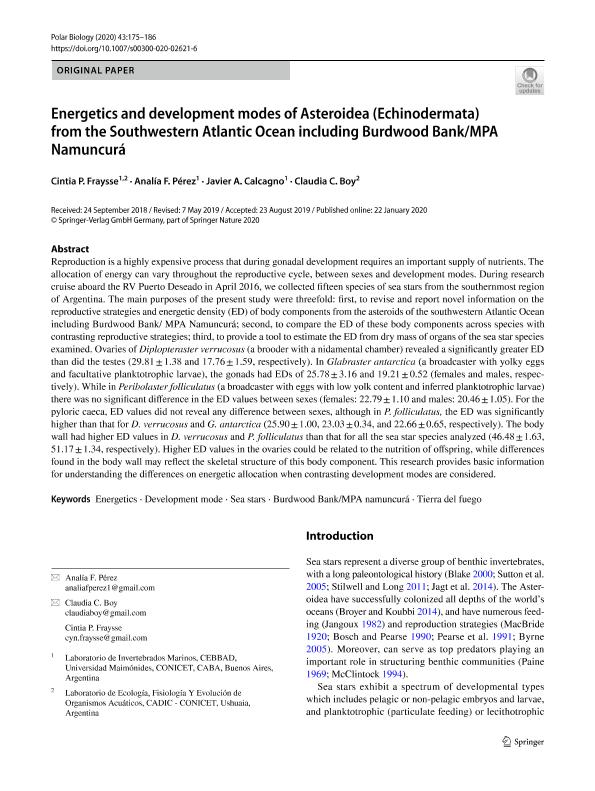Mostrar el registro sencillo del ítem
dc.contributor.author
Fraysse, Cintia Pamela

dc.contributor.author
Pérez, Analía F.
dc.contributor.author
Calcagno, Javier Ángel

dc.contributor.author
Boy, Claudia Clementina

dc.date.available
2021-09-23T12:09:14Z
dc.date.issued
2020-02
dc.identifier.citation
Fraysse, Cintia Pamela; Pérez, Analía F.; Calcagno, Javier Ángel; Boy, Claudia Clementina; Energetics and development modes of Asteroidea (Echinodermata) from the Southwestern Atlantic Ocean including Burdwood Bank/MPA Namuncurá; Springer; Polar Biology; 43; 2; 2-2020; 175-186
dc.identifier.issn
0722-4060
dc.identifier.uri
http://hdl.handle.net/11336/141292
dc.description.abstract
Reproduction is a highly expensive process that during gonadal development requires an important supply of nutrients. The allocation of energy can vary throughout the reproductive cycle, between sexes and development modes. During research cruise aboard the RV Puerto Deseado in April 2016, we collected fifteen species of sea stars from the southernmost region of Argentina. The main purposes of the present study were threefold: first, to revise and report novel information on the reproductive strategies and energetic density (ED) of body components from the asteroids of the southwestern Atlantic Ocean including Burdwood Bank/ MPA Namuncurá; second, to compare the ED of these body components across species with contrasting reproductive strategies; third, to provide a tool to estimate the ED from dry mass of organs of the sea star species examined. Ovaries of Diplopteraster verrucosus (a brooder with a nidamental chamber) revealed a significantly greater ED than did the testes (29.81 ± 1.38 and 17.76 ± 1.59, respectively). In Glabraster antarctica (a broadcaster with yolky eggs and facultative planktotrophic larvae), the gonads had EDs of 25.78 ± 3.16 and 19.21 ± 0.52 (females and males, respectively). While in Peribolaster folliculatus (a broadcaster with eggs with low yolk content and inferred planktotrophic larvae) there was no significant difference in the ED values between sexes (females: 22.79 ± 1.10 and males: 20.46 ± 1.05). For the pyloric caeca, ED values did not reveal any difference between sexes, although in P. folliculatus, the ED was significantly higher than that for D. verrucosus and G. antarctica (25.90 ± 1.00, 23.03 ± 0.34, and 22.66 ± 0.65, respectively). The body wall had higher ED values in D. verrucosus and P. folliculatus than that for all the sea star species analyzed (46.48 ± 1.63, 51.17 ± 1.34, respectively). Higher ED values in the ovaries could be related to the nutrition of offspring, while differences found in the body wall may reflect the skeletal structure of this body component. This research provides basic information for understanding the differences on energetic allocation when contrasting development modes are considered.
dc.format
application/pdf
dc.language.iso
eng
dc.publisher
Springer

dc.rights
info:eu-repo/semantics/openAccess
dc.rights.uri
https://creativecommons.org/licenses/by-nc-sa/2.5/ar/
dc.subject
BURDWOOD BANK/MPA NAMUNCURÁ
dc.subject
DEVELOPMENT MODE
dc.subject
ENERGETICS
dc.subject
SEA STARS
dc.subject
TIERRA DEL FUEGO
dc.subject.classification
Biología Marina, Limnología

dc.subject.classification
Ciencias Biológicas

dc.subject.classification
CIENCIAS NATURALES Y EXACTAS

dc.title
Energetics and development modes of Asteroidea (Echinodermata) from the Southwestern Atlantic Ocean including Burdwood Bank/MPA Namuncurá
dc.type
info:eu-repo/semantics/article
dc.type
info:ar-repo/semantics/artículo
dc.type
info:eu-repo/semantics/publishedVersion
dc.date.updated
2021-08-19T19:58:53Z
dc.journal.volume
43
dc.journal.number
2
dc.journal.pagination
175-186
dc.journal.pais
Alemania

dc.description.fil
Fil: Fraysse, Cintia Pamela. Consejo Nacional de Investigaciones Científicas y Técnicas. Centro Austral de Investigaciones Científicas; Argentina. Universidad Maimónides. Área de Investigaciones Biomédicas y Biotecnológicas. Centro de Estudios Biomédicos, Biotecnológicos, Ambientales y de Diagnóstico; Argentina
dc.description.fil
Fil: Pérez, Analía F.. Universidad Maimónides. Área de Investigaciones Biomédicas y Biotecnológicas. Centro de Estudios Biomédicos, Biotecnológicos, Ambientales y de Diagnóstico; Argentina
dc.description.fil
Fil: Calcagno, Javier Ángel. Universidad Maimónides. Área de Investigaciones Biomédicas y Biotecnológicas. Centro de Estudios Biomédicos, Biotecnológicos, Ambientales y de Diagnóstico; Argentina. Consejo Nacional de Investigaciones Científicas y Técnicas; Argentina
dc.description.fil
Fil: Boy, Claudia Clementina. Consejo Nacional de Investigaciones Científicas y Técnicas. Centro Austral de Investigaciones Científicas; Argentina
dc.journal.title
Polar Biology

dc.relation.alternativeid
info:eu-repo/semantics/altIdentifier/url/http://link.springer.com/10.1007/s00300-020-02621-6
dc.relation.alternativeid
info:eu-repo/semantics/altIdentifier/doi/https://doi.org/10.1007/s00300-020-02621-6
Archivos asociados
